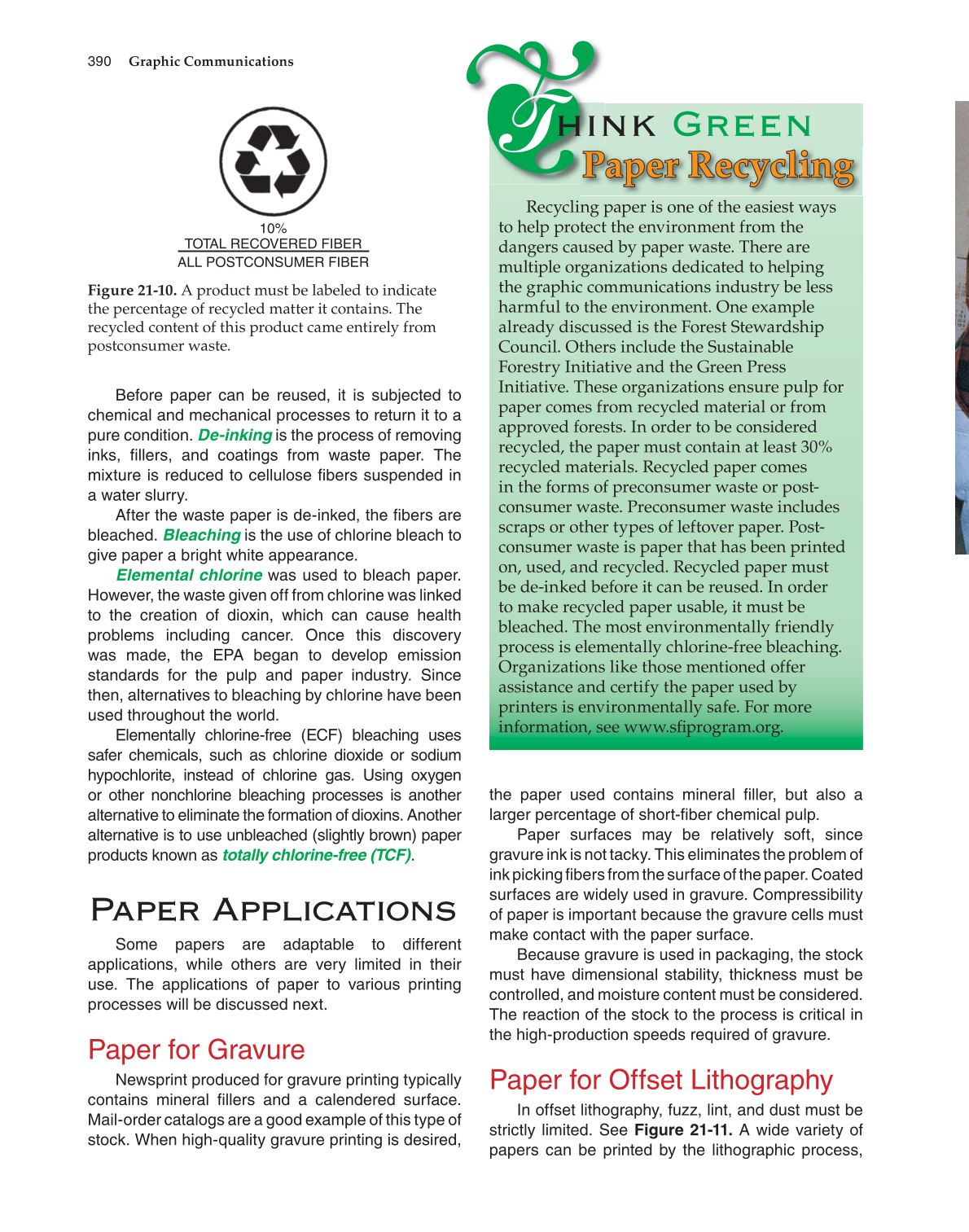390 Graphic Communications
Before paper can be reused, it is subjected to
chemical and mechanical processes to return it to a
pure condition. De-inking is the process of removing
inks, fi llers, and coatings from waste paper. The
mixture is reduced to cellulose fi bers suspended in
a water slurry.
After the waste paper is de-inked, the fi bers are
bleached. Bleaching is the use of chlorine bleach to
give paper a bright white appearance.
Elemental chlorine was used to bleach paper.
However, the waste given off from chlorine was linked
to the creation of dioxin, which can cause health
problems including cancer. Once this discovery
was made, the EPA began to develop emission
standards for the pulp and paper industry. Since
then, alternatives to bleaching by chlorine have been
used throughout the world.
Elementally chlorine-free (ECF) bleaching uses
safer chemicals, such as chlorine dioxide or sodium
hypochlorite, instead of chlorine gas. Using oxygen
or other nonchlorine bleaching processes is another
alternative to eliminate the formation of dioxins. Another
alternative is to use unbleached (slightly brown) paper
products known as totally chlorine-free (TCF).
Paper Applications
Some papers are adaptable to different
applications, while others are very limited in their
use. The applications of paper to various printing
processes will be discussed next.
Paper for Gravure
Newsprint produced for gravure printing typically
contains mineral fi llers and a calendered surface.
Mail-order catalogs are a good example of this type of
stock. When high-quality gravure printing is desired,
the paper used contains mineral fi ller, but also a
larger percentage of short-fi ber chemical pulp.
Paper surfaces may be relatively soft, since
gravure ink is not tacky. This eliminates the problem of
ink picking fi bers from the surface of the paper. Coated
surfaces are widely used in gravure. Compressibility
of paper is important because the gravure cells must
make contact with the paper surface.
Because gravure is used in packaging, the stock
must have dimensional stability, thickness must be
controlled, and moisture content must be considered.
The reaction of the stock to the process is critical in
the high-production speeds required of gravure.
Paper for Offset Lithography
In offset lithography, fuzz, lint, and dust must be
strictly limited. See Figure 21-11. A wide variety of
papers can be printed by the lithographic process,
10%
TOTAL RECOVERED FIBER
ALL POSTCONSUMER FIBER
Figure 21-10. A product must be labeled to indicate
the percentage of recycled matter it contains. The
recycled content of this product came entirely from
postconsumer waste.
Recycling paper is one of the easiest ways
to help protect the environment from the
dangers caused by paper waste. There are
multiple organizations dedicated to helping
the graphic communications industry be less
harmful to the environment. One example
already discussed is the Forest Stewardship
Council. Others include the Sustainable
Forestry Initiative and the Green Press
Initiative. These organizations ensure pulp for
paper comes from recycled material or from
approved forests. In order to be considered
recycled, the paper must contain at least 30%
recycled materials. Recycled paper comes
in the forms of preconsumer waste or post-
consumer waste. Preconsumer waste includes
scraps or other types of leftover paper. Post-
consumer waste is paper that has been printed
on, used, and recycled. Recycled paper must
be de-inked before it can be reused. In order
to make recycled paper usable, it must be
bleached. The most environmentally friendly
process is elementally chlorine-free bleaching.
Organizations like those mentioned offer
assistance and certify the paper used by
printers is environmentally safe. For more
information, see www.sfi program.org.
❦
Think
Green
Paper Recycling Paper Recycling
